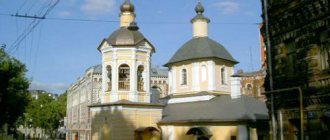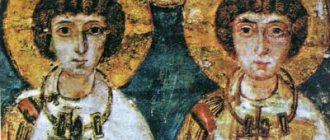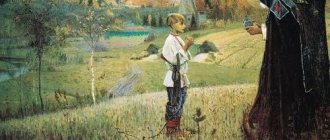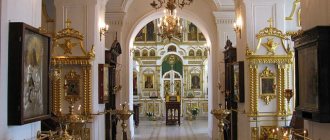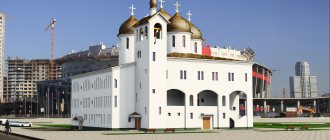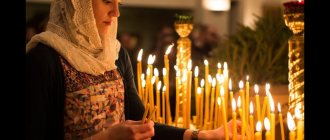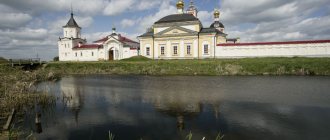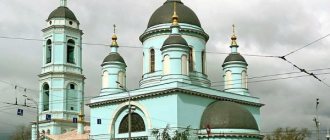02.07.2015
- 2.72
Votes: 273
for the 700th anniversary of the Venerable
Sergius of Radonezh (in the world Bartholomew; “Radonezh” is a toponymic nickname; May 3, 1314 - September 25, 1392) - monk of the Russian Church, founder of the Trinity Monastery near Moscow (now the Trinity-Sergius Lavra), transformer of monasticism in Northern Russia. Sergius of Radonezh is revered by the Russian Orthodox Church as a saint and is considered the greatest ascetic of the Russian land. Days of remembrance according to the Julian calendar: July 5 (discovery of relics), September 25 (death).
sections
|
Personality and era
“There are names that were borne by historical people who lived at a certain time, who did historically known work in life, but names that have already lost their chronological significance and have emerged from the boundaries of time. This is because the work done by such a person, in its significance, went so far beyond the boundaries of his century, so deeply captured the life of subsequent generations, that from the person who did it, in the consciousness of these generations, everything temporary and local gradually fell away, and it is from the historical the figure turned into a popular idea, and his very deed from a historical fact became a practical commandment.”
V.O. Klyuchevsky about Sergius of Radonezh
“The ascetic life of Sergius, introducing high moral Teaching into life by his personal example, marked a New Era in the life of the Russian Land”
E.I. Roerich
Each era shows us its own examples - each time is rich in its saints. And in the most difficult periods such great lamps of faith appeared in Rus' as St. Sergius of Radonezh. His life, his feat, addressed primarily to people, still ignite and inspire our hearts. The very personality of the saint brings joy and light into our lives. “Saints are living rays of divine light,” said Bishop Alexander Semenov-Tyan-Shansky. They illuminated the lives of their contemporaries and continue to illuminate our lives.
» « The founder of the first monastic hostel (kinoviki) was the great Russian ascetic Sergei of Radonezh. Sergei spoke little... but when he spoke, they listened to him, because he spoke the point. An aura of holiness and respect was created around the monastery of Sergius, and the disciples of the ascetic themselves, with his blessing, began to found communal monasteries. The effectiveness of this kind of spiritual expansion was enormous. Each monastery played the role of not only a church, but also a hospital, a school, and a library. Of course, there were fewer doctors among the monks than in a modern clinic, and there were fewer books than in the library of the Academy of Sciences, but doctors treated, and books were read.”
L.N. Gumilyov from the book “From Rus' to Russia”.
| Sergius of Radonezh: collection / comp. V.A. Desyatnikov. - M.: PATRIOT, 1991. - 539 p. Historical and artistic illustrated book about the great ascetic of the Russian land, the inspirer of the Kulikovo victory of 1380, St. Sergius of Radonezh. The collection presents the best examples of ancient Russian literature about Sergius and his students; reflections on the role of the Reverend, written by authors of the 19th century; works of the early 20th century dedicated to Sergius, as well as essays by writers - our contemporaries. The book was published on the 600th anniversary of the repose of St. Sergius of Radonezh. |
| Lives of the Saints: St. Dmitry of Rostov: Vol.: September.-M.: Terra - Book Club, 2007.- 544 p. The lives of saints have long been the main content of the Menaion-Chetiy - works of Russian church-historical and spiritual-teacher literature. Narratives about the lives of the saints of the Orthodox Church are presented in the Menaions of the Fourth in the order of the months and days of each month. Of the four known works of this kind, the Menaion-Cheti of St. Demetrius of Rostov, written in Church Slavonic, have served as the favorite reading of the Russian Orthodox people since the 18th century. In 1900 they began to be published in Russian. |
| Borisov N.S. Sergius of Radonezh / N.S.Borisov. - M.: Mol. Guard, 2003.-298[6] p.: ill. — (Life of remarkable people: Ser. biogr.; Issue 836). For the first time in the “Life of Remarkable People” series, a biography of one of the greatest Russian saints - St. Sergius, the Wonderworker of Radonezh, is published. He was called “Hegumen of the Russian Land” during his lifetime. But Sergius’s life was by no means confined to the walls of the Trinity Monastery he created; he is rightfully considered a major political figure of the era of the Battle of Kulikovo. So what kind of person was this? What role did he play in the history of Russia? What were his moral ideals and political views? How was his relationship with the “powers of this world”? The author of the book, the famous historian Nikolai Sergeevich Borisov, based on many years of scrupulous research of all surviving sources, restores the true, and not the legendary, biography of our great compatriot. |
| Charskaya, L.A. One for all. The story of the life of the great ascetic of the Russian Land / L.A. Charskaya. - M.: MP “Doll House”, TPO “Svetoch”, 1992.- 112 p.: ill. In the proposed story, the life of Sergius of Radonezh is told on the basis of chronicles and legends, which over the centuries have passed from generation to generation and are certified by history. Trying to preserve the flavor of the era in the story itself and keeping in mind young readers, the author at the same time sought from the outside to give his work a form that could not only sufficiently interest them, but also introduce them to that special world. where the entire ascetic life and activity of this truly national hero of work and faith took place |
| Skrynnikov R.G. Saints and authorities / R. G. Skrynnikov. - L.: Lenizdat, 1990. - 349 p. The book is dedicated to the pivotal events of Russian history of the 14th - early 17th centuries - from the Battle of Kulikovo to the period of the Time of Troubles. It explores the role of the clergy in these events and reveals the relationship between secular and ecclesiastical authorities. Having chosen the biographical genre, the author gives vivid biographies of outstanding church figures in Russia. The book was written by the famous historian R. G. Skrynnikov, author of the books “Ivan the Terrible”, “Boris Godunov”, “Minin and Pozharsky”, “Hard Years”, etc. The book is intended for a wide range of readers. |
| Great prophecies about Russia / author's compilation. S.N. Burin. - M.: Astrel: Olympus: AST, 2000. - 384 S. - (Great prophecies). This book is about the mysteries, amazing facts and paradoxes of Russian history. It includes the predictions of nine prominent prophets. Many of the prophecies have already come true. Will the pictures they painted of our future become reality? |
| Guide to the Holy Places of Russia / author - comp. I.E. Gusev. - Minsk: Harvest, 2005. - 160 S.: ill., photo. Holy Rus' is rich in spiritual treasures, a hundred times greater than all worldly blessings. Every year, millions of believers set off on the journey: some to visit churches where the relics of holy saints are kept, healing those who apply themselves to them with faith, others to miraculous icons that console in sorrow and sorrow. The book provides information not only about the most famous monasteries and churches - their history and today, but also about the saints with whom their origin is connected; at the end of each chapter the route to follow is indicated, as well as the exact location address and telephone number of help services. |
Part one The Life of St. Sergius of Radonezh
Birth of St. Sergius
The Monk Sergius was a native of Rostov, rightly famous for its ancient holiness - in this city the light of Christian grace shone for the first time in northeastern Rus'.
The parents of the future Reverend - boyar Kirill, who served first with the Rostov prince Konstantin II Borisovich, and then with Konstantin III Vasilyevich, and his wife Maria - although they belonged to the highest Rostov aristocracy, they were not very wealthy. Kirill and Maria were kind and godly people. Their righteousness was known not only to God, but also to people. Strict guardians of all church statutes, they helped the poor with all their zeal. They lived in the ancestral estate of boyar Kirill, located on the site of the current Varnitsky monastery. Cyril and Maria already had a son, Stefan, when God gave them another son - the future founder of the Trinity Lavra.
Even before the birth of the future Reverend, a miracle occurred that amazed not only his parents, but also everyone around him. When the child was still in the womb, one Sunday, his mother came to church, as usual, for the holy liturgy. She stood with other women in the vestibule, and when they were about to begin reading the Holy Gospel and all the people stood in silence, the baby suddenly cried out in the womb, so that many were amazed at this cry - the glorious miracle that happened to the baby. And then again, at the very beginning of the Cherubim song, at the words “Like the Cherubim...”, the baby suddenly began to squeal loudly in the womb, even louder than the first time, and his voice resounded throughout the church. His mother stood in horror, and the women who were there were perplexed and said: “What will happen to this baby?” When the priest exclaimed: “Let us take notice. Holy to holies!” – the baby screamed loudly again, for the third time.
His mother almost fell to the ground from strong fear and, horrified, overwhelmed by strong trepidation, began to cry quietly. The rest of the women came up to her and began to ask: “Isn’t there a baby in diapers in your bosom, we heard a child’s cry heard throughout the whole church?” She, at a loss, because of strong sobs, could not answer them, she only said: “Ask,” she said, “others, but I don’t have a child.” They inquired, asking each other, searched and did not find, then they turned to Mary again, saying: “We searched throughout the church and did not find the baby. Who is the baby who cried? His mother, unable to conceal what had happened and what they were asking about, answered them: “I don’t have a baby in my bosom, as you think, but I have a child in my womb, not yet born. He screamed." The women said to her: “How can a child before birth, while still in the womb, be given a voice?” She answered: “I’m surprised at this myself, I’m completely overwhelmed with fear and trembling, not understanding what happened.”
The women, sighing and beating their chests, each returned to their place, saying to themselves: “What kind of child will this be? May the will of the Lord be done about him.” The men who were in the church and heard and saw all this stood silently in horror until the priest finished the holy liturgy, took off his vestments and dismissed the people. Everyone went home, and everyone who heard it was scared. As is known, such a phenomenon did not exist either before or after; it is impossible to explain it in any way, either then or now.
After this sign, Mary - his future mother - carried the baby in her womb, like some priceless treasure, like a precious stone, like a wonderful pearl and like a chosen vessel. All the time when she was pregnant, she vomited herself from all filth and all uncleanness, protected herself by fasting, avoided all modest food, did not eat meat, milk and fish, eating only bread and vegetables; Maria completely abstained from wine, and instead of various drinks she drank only water, and then little by little.
The zealous prayer book, noblewoman Maria, now felt a special need in her heart for prayer; therefore, she often moved away from human gaze and in the silence of solitude with tears poured out before God her fervent maternal prayer for the future fate of her baby. "God! - she said then, - save and preserve me, Your wretched servant; save and protect this baby carried in my womb, You are the Lord who wounds babies
(see Ps. 115:5); may Thy will be done, O Lord, upon us, and may Thy name be blessed forever!”
This is how she lived until the birth of the child, she was especially diligent in fasting and prayers, so that the very conception and birth of the child were filled with fasting and prayers. Mary was virtuous and very God-fearing, and already before the birth of the baby she understood and understood this miraculous sign and phenomenon about him. She consulted with her husband, saying: “If we have a boy, let’s, according to a vow, bring him to church and give him to God, the Benefactor of all.”
Unfortunately, despite all the wonderful events that accompanied the birth of the future Reverend, the exact date of his birth is unknown to us. At that time, only the births of princes were recorded, and even then not always. According to various researchers, both ancient and modern, the dates range from approximately 1314 to 1322. Therefore, usually deducing a certain average date, the year of birth of the Rev. is considered to be 1319.
Infancy
The newborn baby continued to amaze his parents with his oddities: when it happened that the mother ate some kind of meat food until she was full, then the baby did not want to take the breast; and this happened more than once, but sometimes for a day, sometimes for two days the child did not eat. Because of this, the baby’s mother and all the relatives were dejected with fear and sadness; they hardly understood that the baby did not want to drink milk when the mother feeding him was eating meat, but agreed to drink only if she was not allowed to fast. From that time on, the mother abstained from food and fasted, and the baby began to feed on her milk all the days, as it should be.
The day came to fulfill his mother’s vow: after six weeks, that is, on the fortieth day after the birth of the child, the parents brought him to the Church of God, giving him, as they promised, to God, who gave him. They immediately ordered the priest to perform Divine Baptism on him. The priest, having read the baby and read many prayers over him, with spiritual joy and diligence baptized him in the name of the Father and the Son and the Holy Spirit and named him Bartholomew in Holy Baptism. The priest took the child, who had abundantly received the grace of Baptism from the Holy Spirit, from the font, and, overshadowed by the Divine Spirit, the priest foresaw and foresaw that this baby would be a chosen vessel.
His father and mother knew the Holy Scriptures well and told the priest how their son, while still in his mother’s womb, shouted three times in church. “We don’t know what this means,” they said. A priest named Michael, who knew the sacred books well, told them from the Divine Scripture, from both Laws, Old and New, the following: “David said in the Psalter: Thy eyes saw my birth.
(Ps. 139:16), and the Lord Himself, with His holy lips, said to His disciples:
because you were with Me from the beginning
(John 15:27).
There, in the Old Testament, Jeremiah the prophet was sanctified in his mother’s womb, and here, in the New Testament, the Apostle Paul exclaims: God, who chose me from my mother’s womb and called me by His grace, was pleased to reveal His Son in me, so that I might preach His gospel to the Gentiles
... (Gal. 1:15–16). And the priest told the parents many other things from Scripture, but about the baby he said: “Do not grieve for him, but, on the contrary, rejoice and be glad, for he will be a chosen vessel of God, the abode and servant of the Holy Trinity,” which came true. Having blessed the child and parents, the priest sent them home.
A short time after baptism, the baby himself became a great faster: on Wednesdays and Fridays he did not touch his mother’s nipples and did not want to taste cow’s milk, but he remained without food for whole days. At first, his mother thought that the child was sick with something and tried to find him a wet nurse, but baby Bartholomew refused the milk of wet nurses even on non-fasting days. In the end, making sure that abstinence did not harm the child, Maria came to terms with it. Growing up, Bartholomew continued to amaze his parents with his oddities; he was not at all drawn to children's amusements, and he was distinguished by rare piety even in a pious family.
Literacy training
When Bartholomew was seven years old, his parents sent him to learn to read and write, but unlike his older brother Stefan and his younger brother Peter, who at that time was about six years old, who quickly mastered reading and writing, Bartholomew could not learn to read. The mentor diligently taught Bartholomew, but the boy did not understand him, studied poorly and lagged behind his comrades who studied with him. The teacher punished him, his comrades reproached him and even laughed at him, his parents persuaded him, and he himself strained all the efforts of his childish mind, spent his nights over a book, fervently and earnestly prayed to the Lord God: “Give me, Lord, to understand this letter; Teach me, O Lord, enlighten me and enlighten me!” But he was still not given a diploma.
Bartholomew's parents greatly mourned the inability of their middle son to comprehend the Divine Scripture, and the teacher was very upset that his work was in vain. Everyone was sad, not knowing the highest destiny of Divine Providence, not knowing what God would do with this youth, that the Lord would not leave His Reverend. According to God's vision, it was necessary that he receive book knowledge from God, and not from people, which came true.
One day, boyar Kirill's horses disappeared; he sent his middle son Bartholomew to look for them. While looking for horses, he suddenly saw a certain hieromonk praying under an oak tree in a field. The reverent and angelic old man brought here his fervent tearful prayers to the omnipresent God. Seeing him, the youth first bowed humbly, then came up and stood close, waiting for him to finish his prayer.
Having prayed, the elder looked at the youth, seeing in him with his spiritual eyes the chosen vessel of the Holy Spirit, affectionately called him to him, blessed him, kissed him fatherly and asked: “What do you need, child?” The youth said: “My soul desires most of all to learn to read and write, for this I was given to study. Now my soul is sad that I am learning to read and write, but I cannot overcome it. You, holy father, pray to God for me, so that I can learn to read and write.”
The elder raised his hands, raised his eyes to heaven, sighed before God, prayed fervently and after the prayer said: “Amen.” Then he carefully took out a small reliquary from his bosom. Having opened it, he took from there with three fingers a small particle of the holy prosphora and, blessing Bartholomew with it, said: “Take this, child, and eat; this is given to you as a sign of the grace of God and the understanding of Holy Scripture. Don’t look at the fact that a particle of holy bread is so small – the sweetness of eating it is great.”
With reverence he tasted the holy bread - and how sweet this mysterious food seemed to him! “Isn’t this what the psalms say? - he said to the elder, - How sweet are Your words to my throat! Better than honey to my lips
...
and my soul
...
loved them greatly!
(Ps. 119: 103, 167).” “If you believe, child,” the elder answered him, “you will see more than these. And do not grieve about literacy, know that from now on the Lord will give you book understanding more than your brothers and comrades, so that you will use others too.” Rejoicing in soul and heart, Bartholomew listened to his soul-helping instructions; like the seeds of the good soil, so the gracious words of the elder fell on his heart. After this, the elder wanted to go on his way, but Bartholomew earnestly asked him to visit his parents’ house. He fell at the feet of the elder, saying: “My parents love people like you very much, father!” The elder, surprised by the boy’s faith, went to his parents’ house.
Seeing the elder, Bartholomew's parents came out to meet him and bowed. For pious people, such an elder monk is always a welcome guest, and Cyril and Maria especially loved to receive and host monks in their house. The elder blessed them, and a meal was prepared for him in the house.
But before sitting down to the proposed meal, the elder, taking Bartholomew with him, went to his former home chapel to sing the funeral service. While the hours were being sung, he ordered the youth to read a psalm, and when Bartholomew said: “I don’t know how to do this, father.” The elder replied: “I told you that from this day on the Lord will grant you the knowledge of literacy. Read the Word of God without doubt.” And then something amazing happened: the boy, having received a blessing from the elder, began to verse the Psalter very clearly and harmoniously, and from that hour he knew how to read and write well. The parents and brothers of the boy, seeing and hearing this, were surprised at his unexpected skill and wisdom and glorified God, who had given him such grace.
Coming out of the chapel, the hosts offered the elder a meal. The elder tasted the food, blessed the boy’s parents and wanted to leave, but the boyars begged the elder to stay with them, asking him and saying: “Father Lord! Stay a little longer so that we can question you, and you would calm and console our feeble-mindedness and our sadness. Here is our humble youth, whom you bless and praise and for whom you predict many blessings - he surprises us, and we grieve for him, because something terrible, amazing and incomprehensible happened to him. When he was in the womb, shortly before his birth, his mother was in church, and he cried out three times in the womb in front of the people, during the liturgy. Nothing like this has ever been heard or seen anywhere, and we are afraid of it, not understanding how it will all end and what will happen in the future.”
The holy elder, foreseeing the future in spirit, said to them: “Oh, blessed spouses! The Lord has honored you with such great mercy - he has given you such a son; Why are you afraid where there is no fear? You should be glad that God blessed you with such a child. He chose your son before he was born. And that I am telling you the truth - this is a sign for you: from now on, the boy will well understand all book wisdom, and will freely read the Divine Scripture. Know that your son will be great before God and people for his virtuous life!”
Already on the threshold of the house, he once again turned to Bartholomew’s parents and uttered these mysterious words: “The Youth will once be the abode of the Most Holy Trinity, he will lead many with him to the understanding of the Divine commandments.” Having said this, the elder left the house; the owners accompanied him to the gate, but he suddenly became invisible. Cyril and Maria involuntarily wondered if an Angel of God had been sent to them to bestow wisdom on their son.
Meanwhile, as the elder said, it came true: a wonderful change happened to the youth. Whatever book he opened, he immediately began to read it without any difficulty, understanding the meaning of what he was reading. Thus, the gift of God, so unexpectedly sent down to him, acted in young Bartholomew and enlightened his mind. After this incident, he soon surpassed both his brothers and other comrades in learning.
Memorable places associated with the name of Sergius of Radonezh.
| The Varnitsky Monastery was built on the spot where Sergius was born. |
| Monument to Sergius of Radonezh in Sergiev Posad |
| Trinity Cathedral of the Trinity-Sergius Lavra |
| Sergius of Radonezh at the Monument “1000th Anniversary of Russia” in Veliky Novgorod |
| Radonezh, monument to Sergius of Radonezh. |
The image of Sergius of Radonezh in fiction
From the darkness of centuries you rose and became stronger. Holy Rus' is your beginning, and St. Sergius is in it. S. Nikulin Borodin S.P. Dmitry Donskoy: novel / S.P. Borodin; — M.: RIPOL, 1993. — 382С.The novel, written with great love for the native people, their history and culture, tells about the struggle of the Russian people under the leadership of Prince Dmitry Donskoy with the Golden Horde, about the historical victory of Russian troops on the Kulikovo Field (1380). The era of Rus''s rapid rise in the struggle against conquerors and the establishment of Moscow as a national center are clearly reflected. The folk theme is well developed. When writing the novel, the author used folklore and chronicle materials.
Balashov D.M. Collected Works.V 6 T. / D.M. Balashov.T.5.: Wind of Time: Rroman / Balashov, D.M. - M.: Khudozh.Lit., 1993. - 574 P.This is the fifth book in the “Sovereigns of Moscow” series. The novel will tell us about the time from 1353 to the first years of the reign of Dmitry Donskoy. We will talk about the activities of Metropolitan Alexy, who actually ruled the country during the reign of Ivan the Red.
Balashov, D.M. Praise of Sergius: a historical novel / D.M. Balashov. - M.: Astrel: AST: Guardian, 2007. - 842 S.: ill.A novel by the famous writer-historian D.M. Balashov (1927-2000) is dedicated to the great ascetic of the Russian land, St. Sergius of Radonezh. In the book “Praise of Sergius,” the writer continues the main theme of his work - the story of the creation of Muscovite Rus'. The hero of this novel is Rostovite Bartholomew Kirillovich, monastically Sergius of Radonezh. By the will of fate, he became the center of that powerful spiritual movement that brought Vladimir Rus to the Kulikovo Field and created a new state on the ruins of Kievan Rus - Muscovite Russia. The reader experiences the glorious and difficult life of this legendary man from birth to death.
Balashov, D. M. Steppe prologue: The first book of the trilogy “Holy Rus'” / D. M. Balashov. - M.: Astrel: AST, 2009. - 448 p.This volume includes the first book of the trilogy “Holy Rus'” by the famous writer D. M. Balashov from the series of historical novels “The Sovereigns of Moscow”.
The image of Sergius of Radonezh in paintings by Russian artists
| Mikhail Vasilyevich Nesterov “The Youth of St. Sergius of Radonezh.”, 1892-1897. |
| M. V. Nesterov “Vision to the Youth Bartholomew”, 1890 |
| M. V. Nesterov “Works of Sergius of Radonezh” (triptych), 1896 - 1897. |
| Sergei Alekseevich Kirillov “Reverend Sergius of Radonezh. (Blessing)", 1992 |
| Nicholas Konstantinovich Roerich “St. Sergius of Radonezh.”, 1932 |
| N.K. Roerich “Sergius the Builder” 1940 |
| Ernst Ernestovich Lissner “Trinity-Sergius Lavra” 1907 |
| Alexey Danilovich Kivshenko “Reverend Sergius blesses D. Donskoy”, 1881 (?) |
| Alexander Nikonorovich Novoskoltsev “Reverend Sergius blesses Dmitry for the fight against Mamai”, 1882 (?) |
| Sergei Vladimirovich Chikunchikov “The Resurrection of the Youth by St. Sergius of Radonezh” 1999 |
| Viktor Mikhailovich Vasnetsov “Sergius of Radonezh”, 1882 |
E. Golubinsky
TABLE OF CONTENTS
<FROM THE AUTHOR>
I. LIFE OF THE REVEREND SERGIUS
About the place belonging to St. Sergius in the host of our ascetics, and about the proposed outline of his life - 1
Parents of St. Sergius - 9
A wonderful omen about him before his birth - 12
Place and time of his birth - 13
His significant and unusual behavior in infancy - 17
His natural inability to read and write and his miraculous receipt of the gift for it - 18
The beginning of his asceticism in early youth - 19
Relocation of his parents from Rostov to Radonezh - 19
His intention to accept monasticism, postponed by the will of his parents - 22
Death of his parents - 22
The intention of St. Sergius to retire to the desert for asceticism, and not to go to any monastery - 22
His departure into the desert in community with his older brother Stephen and his choice with his brother of a place to settle - 23
He and his brother built a cell and a church - 25
Stephen's removal from him from the desert and his loneliness in the latter - 25
The tonsure of St. Sergius into monasticism - 25
His two-year solitary asceticism in the desert - 26
The coming to him and the settlement of monks with him is the beginning of his monastery - 29
The initial number of brethren in the monastery and the absence of a hieromonk among them; fencing the monastery with tyn; original space and original appearance of the monastery - 30
The first short-lived abbot of the monastery was Mitrofan, who tonsured St. Sergius, and then Sergius himself - 31
The arrival of Archimandrite Simon of Smolensk to Sergius of Smolensk, who brought him money to rebuild the monastery, and the increase in brethren in the monastery - 32
The initial poverty of the monastery - 33
The settlement of the surroundings of the monastery by lay farmers and the zeal for the monastery of its new neighbors - 35
Return to St. Sergius of his elder brother Stephen with his 12-year-old son John, in monasticism Theodore - 36
Introduction by St. Sergius of a hostel in his monastery - 36
Imitation of St. Sergius to St. Theodosius of Pechersk in his hegumen activity (regarding the acceptance into the monastery of those wishing to become a monk, regarding tonsure into the small and great image, regarding supervision of the brethren) - 40
The activities of the monks of the monastery and the care of St. Sergius about compiling a library of four books - 40
The participation of St. Sergius in all monastic work on an equal basis with the brethren and his greater zeal for work than anyone else - 41
Venerable Sergius wearing not only the same clothes as all the brethren, but also worse than any of the brethren - 42
The case of the thin attire of St. Sergius - 42
The question of whether the monastery of St. Sergius owned immovable estates or estates under himself - 43
Portrayal of the personal character and moral qualities of St. Sergius by his biography and other contemporaries - 44
The love of poverty and strangeness of St. Sergius - 44
Message to him from the Patriarch of Constantinople Callistus - 47
His removal from the Trinity Monastery due to Stefanov’s lust for power and his construction of a new monastery for himself (Kirzhachsky) - 48
His return to the Trinity Monastery - 50
Miracles of St. Sergius performed during his lifetime: bringing out the source; resurrection of the youth; healing of a raging nobleman; healing of the seriously ill; denunciation of the covetous; defeat of an unbelieving Greek bishop by blindness - 51
Cases of the foresight of St. Sergius: the denunciation of the servant of Prince Vladimir Andreevich, who brought food and drink from the prince to the monastery; absentee greeting to St. Stephen of Perm - 56
Visions of St. Sergius that were given to his disciples: an angel serving with him; divine fire - 57
The great glory of St. Sergius in the Russian land - 57
The desire of St. Metropolitan Alexei to leave St. Sergius as his successor at the metropolitan see - 58
Anger at St. Sergius on the part of Archimandrite Michael (Mitya), appointed as successor to St. Alexei - 59
The closeness of St. Sergius to the Grand Duke Dmitry Ivanovich Donskoy and his participation in state affairs: his baptism of the Grand Duke’s sons; his trip to Nizhny Novgorod to visit Prince Boris Konstantinovich; his trip to Ryazan to visit Prince Oleg Ivanovich; his blessing of the Grand Duke to fight against Mamai, predicting victory for the sovereign over the khan and building two votive monasteries for him (Dubensky Shavykinsky and Dubensky Stromynsky); presence at his death - 60
Removal of St. Sergius to Tver from the invasion of Tokhtamysh - 66
Vision of the “red birds” by St. Sergius - 66
Visit of St. Sergius to the Mother of God - 67
Death of St. Sergius - 68
Celebration of his memory and canonization - 71
Discovery of his relics – 72
The significance of St. Sergius in the history of Northern Russian monasticism - 74
Monasteries built by St. Sergius in fulfillment of the instructions given to him and requests addressed to him: Moscow Simonov, Kolomna Golutvin, Serpukhov Vysotsky, Moscow Andronikov - 76
Monasteries built with the blessing of St. Sergius, given to third-party builders for him: Rostov Ustinsky, Gorokhovets St. George Hermitage - 77
Monasteries built (and arranged in the sense of introducing a hostel) by the disciples and interlocutors of St. Sergius: Rev. Methodius of Pesnosh, Rev. Savva of Zvenigorod, Rev. Sylvester Obnorsky, Rev. Pavel Obnorsky or Komelsky, Rev. Sergius Nuromsky or Obnorsky, Rev. Avramie Galichsky or Chukhlomsky, Rev. Jacob Zheleznoborovsky, Rev. Nikita of Serpukhov-Borovsky (who did not build, but organized the monastery in the indicated sense), Rev. Stefan Makhrischsky, Rev. Demetrius of Prilutsky, Saint Dionysius of Suzdal, Venerable. Euthymius of Suzdal, Rev. Kilill Belozersky, Rev. Ferapont of Belozersk-Mozhaisk, Saint Stephen of Perm - 80
Spread of the hostel introduced by St. Sergius throughout northern Russia - 88
Spread of solitary asceticism introduced by St. Sergius in northern Russia - 89
Disciples of St. Sergius who did not leave his monastery to found their own monasteries - 90
ABOUT THE SIGNIFICANCE OF THE REVEREND SERGIUS OF RADONEZH IN THE HISTORY OF OUR MONACHISM
II. GUIDE TO LAVRA
SOURCES AND REFERENCES – 97
I. GENERAL INFORMATION ABOUT THE MONASTERY – 100
History of the monastery (history of buildings; history of incidents and deeds) Its place among other monasteries San and liturgical advantages of its abbots Name of the monastery Economy and wealth of the monastery Borrowing money from it by sovereigns Its administration Number of monks List of abbots (abbots; archimandrites; archbishops and metropolitans)
II. MONASTERY WALL WITH TOWERS IN IT – 160
The original wooden wall The expansion of the monastery during the construction of the stone wall The construction of this stone wall Its dimensions and structure The towers that were and are in it The outfit or artillery pieces on the wall in the past Former and current residential and non-residential premises in the wall and in the towers Gates in the wall Moat, former near the wall, gouges and bastions Roof of the wall (gate in the wall)
III. CHURCHES, CHURCH TENTS AND BELL TOWERS – 177
1. Trinity Cathedral
The significance of the cathedral in the monastery Wooden churches before the current stone one Construction of the current stone church: the time when its construction began; the material from which it is built; its size and shape, its beauty; its patrons and the continuation of the time of its construction. Exterior of the cathedral: gilding of the dome (head), gilding of the roof, painting of the walls; extension of the porches Interior of the cathedral: remarkable in the altar; former chapel in the southern section of the sanctuary; iconostasis and local icons; royal gates; shrine with the relics of St. Sergius; wonderful icons in the church; ark with particles of relics; wall paintings, chandeliers and lamps Laying a cast-iron floor instead of a wooden one and turning the cathedral from cold to warm Entries in the northern porch of the cathedral
2.
Nikon Church
— 199
3.
Spiritual Church
— 202
4.
Philaret Church
— 204
5.
Assumption Cathedral
— 205
6.
Smolensk Church
— 211
7.
Refectory Church of St. Sergius
— 212
8.
Micah's Church
— 215
9.
Hospital (former) Church of St. Zosima and Savvaty Solovetsky
— 217
10.
Church of St. John Climacus
— 217
11.
Church of the Martyrs Barbara, Anastasia and Aquilina
— 218
12.
Gate Church of John the Baptist
— 218
13.
House Church of the Kazan Mother of God (in the metropolitan chambers)
— 219
14.
House Church of the Intercession of the Mother of God (in the vicar's cells)
— 220
15.
All Saints Church
— 220
Serapion Tent or Tent of Three Relics
— 220
Maksimovskaya tent
— 222
Bell tower
— 222
IV. CELLS AND OTHER BUILDINGS – 227
The initial disorder in the monastery in relation to the cells The orderly appearance that St. Sergius gave the monastery The transformation regarding the location of the cells, carried out in the middle of the 16th century The transformation of the cells from wooden to stone The significance in the history of the cells of the siege of the monastery by the Poles Cells and other buildings of the monastery according to the inventory of the monastery in 1641 Changes in attitude towards cells and other buildings from 1641 to the present
V. SACRY – 251
Sacred and non-sacred objects remaining from the Venerables Sergius and Nikon I. Altar crosses II. Altar Gospels III. Liturgical vessels IV. Airs and coverings for liturgical vessels V. Clothes for the throne and altar VI. Icons VII. Panagia VIII. Mithras IX. Liturgical vestments X. Covers on the shrines of St. Sergius and Nikon XI. Shrouds hanging for icons XII. Easter Shrouds XIII. Censers, palms, bishop's staffs, dishes, bowls, ladles and some things related to church utensils, which, having fallen out of use, were deposited in the sacristy for safekeeping XIV. Non-ecclesiastical items stored in the sacristy
VI. LIBRARY AND ARCHIVE – 267
VII. HOSPITAL AND CEMETERIES – 269
VIII. ASSUMPTION WELL, POOL AND MONUMENT (OBELISK) – 274
IX. ICON-PAINTING, CANDLE PRESSURE, PROSPHERE AND LITHOGRAPHY WITH PHOTOGRAPHY – 277
X. MOSCOW THEOLOGICAL ACADEMY AND THE THEOLOGICAL SEMINARY FORMERLY IN THE LAVRA - 281
XI. CIRCLE OF THE MONASTERY AND THE CURRENT POSAD – 293
Eastern
side of the monastery: Red Square Monastic hotels Lavra house, given over to a tavern, is a monastery almshouse House of charity Posadsky rows Chapel and well Benches and huts Boulevard
South
side of the monastery: a well, mistaken for the well of St. St. Sergius Pyatnitskaya Church or the former Podolny Monastery Hospice House Pafnutyev Garden Kelarsky Pond (Svitoshny Dvor, pancake shops)
Western
side of the monastery: Beer yard Bathhouse
Northern
side of the monastery: Stable yard Volovoy yard Well of St. Savva Vodokachka White Pond
The current settlement: the village of Klementyevo Nizhnyaya Sluzhnaya Sloboda and Pyatnitskaya Church Nativity Church Elijah Parish Ascension Church Kokuevsky Parish Cemeteries Population of the settlement
XII. NOTABLE SURROUNDINGS OF THE MONASTERY – 319
Radonezh (Gorodok) Khotkov Monastery Krestovskaya Chapel, or the place “At the Cross” Bethany Monastery Gethsemane Skete with the Paraclete Korbukha Desert
Addition.
Moscow and St. Petersburg courtyards of the Lavra and the former Moscow Epiphany Monastery attached to it Villages around the Lavra, which until 1764 were in its patrimonial possession or belonged to its patrimonial estates
XIII. Siege of the Lavra by the Poles - 355
XIV. Royal pilgrimage to Trinity - 387
